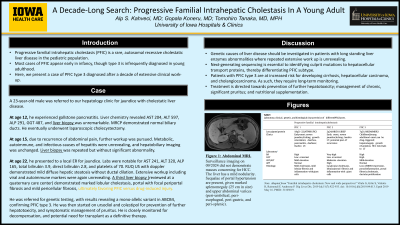Sunday Poster Session
Category: Liver
P1260 - A Decade-Long Search: Progressive Familial Intrahepatic Cholestasis in a Young Adult
Sunday, October 27, 2024
3:30 PM - 7:00 PM ET
Location: Exhibit Hall E

Has Audio
- AK
Alp Kahveci, MD
University of Iowa Hospitals & Clinics
Iowa City, IA
Presenting Author(s)
Alp Kahveci, MD, Gopal Koneru, MBBS, Tomohiro Tanaka, MD, MPH
University of Iowa Hospitals & Clinics, Iowa City, IA
Introduction: Progressive familial intrahepatic cholestasis (PFIC) is a rare, autosomal recessive cholestatic liver disease in the pediatric population. Most cases of PFIC appear early in infancy, though type 3 is infrequently diagnosed in young adulthood. Here, we present a case of PFIC type 3 diagnosed after a decade of extensive clinical work-up.
Case Description/Methods: A 23-year-old male was referred to our hepatology clinic for jaundice with cholestatic liver disease. At age 12, he experienced gallstone pancreatitis. Liver chemistry revealed AST 204, ALT 597, ALP 291, GGT 487, and liver biopsy was unremarkable. MRCP demonstrated normal biliary ducts. He eventually underwent laparoscopic cholecystectomy. Due to recurrence of abdominal pain at age 15, further workup was pursued. Metabolic, autoimmune, and infectious causes of hepatitis were unrevealing, and hepatobiliary imaging was unchanged. Liver biopsy was repeated but without significant abnormality. At age 22, he presented to a local ER for jaundice. Labs were notable for AST 241, ALT 320, ALP 165, total bilirubin 3.9, direct bilirubin 2.8, and platelets of 70. RUQ US with doppler demonstrated mild diffuse hepatic steatosis without ductal dilation. Extensive workup including viral and autoimmune markers were again unrevealing. A third liver biopsy was performed and reviewed at a quaternary care center. Biopsy demonstrated marked lobular cholestasis, portal with focal periportal fibrosis and mild pericellular fibrosis, ultimately favoring PFIC versus drug-induced injury. He was referred for genetic testing, with results revealing a mono-allelic variant in ABCB4, confirming PFIC type 3. He was then started on ursodiol and colestipol for prevention of further hepatotoxicity, and symptomatic management of pruritus. He is closely monitored for decompensation, and potential need for transplant as a definitive therapy.
Discussion: Genetic causes of liver disease should be investigated in patients with long standing liver enzymes abnormalities where repeated extensive work up is unrevealing. Next-generating sequencing is essential to identifying culprit mutations to hepatocellular transport proteins, thereby differentiating PFIC subtype. Patients with PFIC type 3 are at increased risk for developing cirrhosis, hepatocellular carcinoma, and cholangiocarcinoma. As such, they require long-term monitoring. Treatment is directed towards prevention of further hepatotoxicity; management of chronic, significant pruritus; and nutritional supplementation.
Disclosures:
Alp Kahveci, MD, Gopal Koneru, MBBS, Tomohiro Tanaka, MD, MPH. P1260 - A Decade-Long Search: Progressive Familial Intrahepatic Cholestasis in a Young Adult, ACG 2024 Annual Scientific Meeting Abstracts. Philadelphia, PA: American College of Gastroenterology.
University of Iowa Hospitals & Clinics, Iowa City, IA
Introduction: Progressive familial intrahepatic cholestasis (PFIC) is a rare, autosomal recessive cholestatic liver disease in the pediatric population. Most cases of PFIC appear early in infancy, though type 3 is infrequently diagnosed in young adulthood. Here, we present a case of PFIC type 3 diagnosed after a decade of extensive clinical work-up.
Case Description/Methods: A 23-year-old male was referred to our hepatology clinic for jaundice with cholestatic liver disease. At age 12, he experienced gallstone pancreatitis. Liver chemistry revealed AST 204, ALT 597, ALP 291, GGT 487, and liver biopsy was unremarkable. MRCP demonstrated normal biliary ducts. He eventually underwent laparoscopic cholecystectomy. Due to recurrence of abdominal pain at age 15, further workup was pursued. Metabolic, autoimmune, and infectious causes of hepatitis were unrevealing, and hepatobiliary imaging was unchanged. Liver biopsy was repeated but without significant abnormality. At age 22, he presented to a local ER for jaundice. Labs were notable for AST 241, ALT 320, ALP 165, total bilirubin 3.9, direct bilirubin 2.8, and platelets of 70. RUQ US with doppler demonstrated mild diffuse hepatic steatosis without ductal dilation. Extensive workup including viral and autoimmune markers were again unrevealing. A third liver biopsy was performed and reviewed at a quaternary care center. Biopsy demonstrated marked lobular cholestasis, portal with focal periportal fibrosis and mild pericellular fibrosis, ultimately favoring PFIC versus drug-induced injury. He was referred for genetic testing, with results revealing a mono-allelic variant in ABCB4, confirming PFIC type 3. He was then started on ursodiol and colestipol for prevention of further hepatotoxicity, and symptomatic management of pruritus. He is closely monitored for decompensation, and potential need for transplant as a definitive therapy.
Discussion: Genetic causes of liver disease should be investigated in patients with long standing liver enzymes abnormalities where repeated extensive work up is unrevealing. Next-generating sequencing is essential to identifying culprit mutations to hepatocellular transport proteins, thereby differentiating PFIC subtype. Patients with PFIC type 3 are at increased risk for developing cirrhosis, hepatocellular carcinoma, and cholangiocarcinoma. As such, they require long-term monitoring. Treatment is directed towards prevention of further hepatotoxicity; management of chronic, significant pruritus; and nutritional supplementation.
Disclosures:
Alp Kahveci indicated no relevant financial relationships.
Gopal Koneru indicated no relevant financial relationships.
Tomohiro Tanaka indicated no relevant financial relationships.
Alp Kahveci, MD, Gopal Koneru, MBBS, Tomohiro Tanaka, MD, MPH. P1260 - A Decade-Long Search: Progressive Familial Intrahepatic Cholestasis in a Young Adult, ACG 2024 Annual Scientific Meeting Abstracts. Philadelphia, PA: American College of Gastroenterology.
